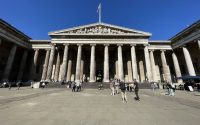French National TV Station Apologizes for Using Artist’s Analysis of Nahel M. Shooting with Police Transcription
A French national TV station apologized this week for its “inappropriate use” of an analysis of the shooting of Nahel M. by a police officer that had been done by Earshot, the investigative agency founded by Turner Prize–winning artist Lawrence Abu Hamdan.
Earshot’s analysis focused on audio captured during the video of police stopping the 17-year-old boy in Nanterre, a suburb of Paris, on June 27. Little is known about Nahel M. beyond the fact that he was a French citizen of Algerian and Moroccan descent and that he reportedly had no criminal record. Pascal Prache, the top prosecutor in Nanterre, has claimed that he had previously not complied with police during traffic stops.
Nahel M.’s killing has spurred protests across France, where the incident has renewed anger over how people of color are treated by the police and other institutions.
In the video, Nahel M. can be seen in a car while two police officers—one holding a gun—confront him. What was said during the incident has been debated by many.
According to the IGPN, France’s national police, one of the police officers said, “Coupe! Les mains derrière la tête,” which could be translated to: “Cut!,” referring to the car’s engine. “Hands behind your head.”
Earshot’s analysis, which did not come with its own transcription, did not offer a concrete interpretation of that portion of the audio. “Audio optimization helps to make the words spoken by the police officers before the shot more distinct,” Index NGO, the group that co-organized the investigation with Earshot, writes on its website. “Nevertheless, the analysis is in progress and does not, in our opinion, allow us to make a formal statement on the content of the oral exchanges that took place in the moments preceding the shooting.”
According to Abu Hamdan, based on the Earshot analysis, the officer says “Ouvre, ouvre” (“Open, open”) and “Pousse-toi” (“Move over”), using the informal form of both verbs in a situation where the formal one might normally be used.
“Though ‘Ouvre, Ouvre’ could be directed at Nahel (instructing him to open his car door) ‘Pousse-toi’ (move over) does not make sense in the context where a gun is pointed at him and the police are leaning on his car,” Abu Hamdan wrote on Instagram. “An alternate thesis could be that the ‘Pousse-toi’ is the gunman’s address to his colleague, instructing him to move out of the way of the shot to come. This would indicate the killing was pre determined.”
The Earshot video was posted to social media by Index NGO, which describes itself as an “autonomous extension” of Forensic Architecture, the investigative agency that lists Abu Hamdan as one of its research fellows. Index NGO’s tweet featuring the video has garnered close to 2,000 likes.
On July 3, Index NGO posted footage from Info France 2’s broadcast of the Earshot video, which features subtitles with the IGPN’s dialogue, along with footage and audio analysis bearing Earshot’s logo. “You make him say the OPPOSITE of our analysis,” Index NGO wrote on Twitter, referring to the police officer with the gun. That post has gained more than 9,000 likes.
The day after, on July 4, Info France 2 issued an apology to Index NGO on social media. “We apologize for this inappropriate use of your audio analysis,” the network wrote, later having one of its anchors say sorry on live television.
In addition to undertaking investigations under the aegis of Earshot, Abu Hamdan has also regularly shown in art galleries, including at the Museum of Modern Art in New York, where his work was on view in a solo show this spring. His videos, installations, and performances regularly take up analysis of audio as a means of truth-telling during conflicts.
Some have questioned the methods of Abu Hamdan, Forensic Architecture, and other research-oriented groups. Emily Watlington wrote in a recent Art in America essay on Forensic Architecture that one of Abu Hamdan’s pieces about a Syrian prison was “doomed to inaccuracy” because it was premised upon “conflicting accounts” presented amid an architectural model that “allows no room for uncertainty or ambiguity.”



